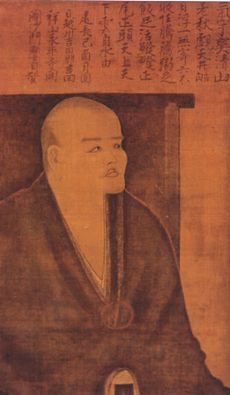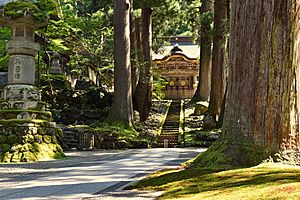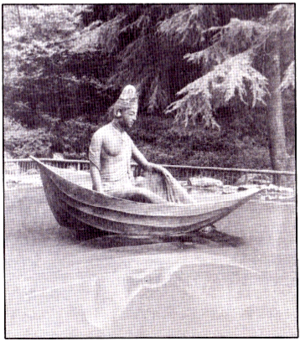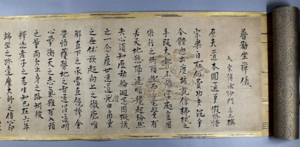Dōgen facts for kids
Quick facts for kids Dōgen |
|
|---|---|
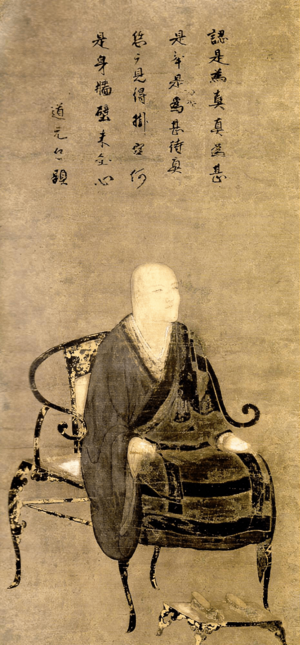 |
|
| Religion | Buddhism |
| School | Sōtō |
| Personal | |
| Born | 26 January 1200 Kyoto, Japan |
| Died | 22 September 1253 (aged 53) Kyoto, Japan |
| Senior posting | |
| Title | Zen Master |
| Predecessor | Rujing |
Dōgen Zenji (道元禅師; 26 January 1200 – 22 September 1253), also known as Dōgen Kigen (道元希玄), Eihei Dōgen (永平道元), Kōso Jōyō Daishi (高祖承陽大師), or Busshō Dentō Kokushi (仏性伝東国師), was a Japanese Buddhist priest, writer, poet, philosopher, and founder of the Sōtō school of Zen in Japan.
Originally ordained as a monk in the Tendai School in Kyoto, he was ultimately dissatisfied with its teaching and traveled to China to seek out what he believed to be a more authentic Buddhism. He remained there for four years, finally training under Tiantong Rujing, an eminent teacher of the Caodong lineage of Chinese Chan. Upon his return to Japan, he began promoting the practice of zazen (sitting meditation) through literary works such as Fukanzazengi and Bendōwa.
He eventually broke relations completely with the powerful Tendai School, and, after several years of likely friction between himself and the establishment, left Kyoto for the mountainous countryside where he founded the monastery Eihei-ji, which remains the head temple of the Sōtō school today.
Dōgen is known for his extensive writing including the Shōbōgenzō (Treasury of the True Dharma Eye, considered his magnum opus), the Eihei Kōroku (Extensive Record, a collection of his talks), Japanese poetry, commentaries, and the Eihei Shingi, the first Zen monastic code written in Japan.
Biography
Early life
Dōgen was probably born into a noble family, though as an illegitimate child of Minamoto Michitomo, who served in the imperial court as a high-ranking ashō (亞相, "Councillor of State"). His mother is said to have died when Dōgen was age 7.
Early training
At some later point, Dōgen became a low-ranking monk on Mount Hiei, the headquarters of the Tendai school of Buddhism.
This question was, in large part, prompted by the Tendai concept of original enlightenment (本覚 hongaku), which states that all human beings are enlightened by nature and that, consequently, any notion of achieving enlightenment through practice is fundamentally flawed.
The Kenzeiki further states that he found no answer to his question at Mount Hiei, and that he was disillusioned by the internal politics and need for social prominence for advancement. Therefore, Dōgen left to seek an answer from other Buddhist masters. He went to visit Kōin, the Tendai abbot of Onjō-ji Temple (園城寺), asking him this same question. Kōin said that, in order to find an answer, he might want to consider studying Chán in China. In 1217, two years after the death of contemporary Zen Buddhist Myōan Eisai, Dōgen went to study at Kennin-ji Temple (建仁寺), under Eisai's successor, Myōzen (明全).
Travel to China
In 1223, Dōgen and Myōzen undertook the dangerous passage across the East China Sea to China (Song dynasty) to study in Jing-de-si (Ching-te-ssu, 景德寺) monastery as Eisai had once done. Around the time the Mongol Empire was waging wars on the various dynasties of China.
In China, Dōgen first went to the leading Chan monasteries in Zhèjiāng province. At the time, most Chan teachers based their training around the use of gōng-àn (Japanese: kōan). Though Dōgen assiduously studied the kōans, he became disenchanted with the heavy emphasis laid upon them, and wondered why the sutras were not studied more. At one point, owing to this disenchantment, Dōgen even refused Dharma transmission from a teacher. Then, in 1225, he decided to visit a master named Rújìng (如淨; J. Nyōjo), the thirteenth patriarch of the Cáodòng (J. Sōtō) lineage of Zen Buddhism, at Mount Tiāntóng's (天童山 Tiāntóngshān; J. Tendōzan) Tiāntóng temple in Níngbō. Rujing was reputed to have a style of Chan that was different from the other masters whom Dōgen had thus far encountered. In later writings, Dōgen referred to Rujing as "the Old Buddha". Additionally he affectionately described both Rujing and Myōzen as senshi (先師, "Ancient Teacher").
Under Rujing, Dōgen realized liberation of body and mind upon hearing the master say, "cast off body and mind" (身心脱落 shēn xīn tuō luò).
Myōzen died shortly after Dōgen arrived at Mount Tiantong. In 1227, Dōgen received Dharma transmission and inka from Rujing, and remarked on how he had finally settled his "life's quest of the great matter".
Return to Japan
Dōgen returned to Japan in 1227 or 1228, going back to stay at Kennin-ji, where he had trained previously. Among his first actions upon returning was to write down the Fukanzazengi (普観坐禅儀; Universally Recommended Instructions for Zazen), a short text emphasizing the importance of and giving instructions for zazen (sitting meditation).
However, tension soon arose as the Tendai community began taking steps to suppress both Zen and Jōdo Shinshū, the new forms of Buddhism in Japan. In the face of this tension, Dōgen left the Tendai dominion of Kyōto in 1230, settling instead in an abandoned temple in what is today the city of Uji, south of Kyōto.
In 1233, Dōgen founded the Kannon-dōri-in in Fukakusa as a small center of practice. He later expanded this temple into Kōshōhōrin-ji (興聖法林寺).
Eihei-ji
In 1243, Hatano Yoshishige (波多野義重) offered to relocate Dōgen's community to Echizen province, far to the north of Kyōto. Dōgen accepted because of the ongoing tension with the Tendai community, and the growing competition of the Rinzai-school.
His followers built a comprehensive center of practice there, calling it Daibutsu Temple (Daibutsu-ji, 大仏寺). While the construction work was going on, Dōgen would live and teach at Yoshimine-dera Temple (Kippō-ji, 吉峯寺), which is located close to Daibutsu-ji. During his stay at Kippō-ji, Dōgen "fell into a depression". It marked a turning point in his life, giving way to "rigorous critique of Rinzai Zen". He criticized Dahui Zonggao, the most influential figure of Song Dynasty Chán.
In 1246, Dōgen renamed Daibutsu-ji, calling it Eihei-ji. This temple remains one of the two head temples of Sōtō Zen in Japan today, the other being Sōji-ji.
Dōgen spent the remainder of his life teaching and writing at Eihei-ji. In 1247, the newly installed shōgun's regent, Hōjō Tokiyori, invited Dōgen to come to Kamakura to teach him. Dōgen made the rather long journey east to provide the shōgun with lay ordination, and then returned to Eihei-ji in 1248. In the autumn of 1252, Dōgen fell ill, and soon showed no signs of recovering. He presented his robes to his main apprentice, Koun Ejō (孤雲懐弉), making him the abbot of Eihei-ji.
Death
At Hatano Yoshishige's invitation, Dōgen left for Kyōto in search of a remedy for his illness. In 1253, soon after arriving in Kyōto, Dōgen died. Shortly before his death, he had written a death poem:
Fifty-four years lighting up the sky.
A quivering leap smashes a billion worlds.
Hah!
Entire body looks for nothing.
Living, I plunge into Yellow Springs.
Miraculous events and auspicious signs
Several "miraculous experiences" and "auspicious signs" have been recorded in Dōgen's life, some of them quite famous. According to Bodiford, "Monks and laymen recorded these events as testaments to his great mystical power," which "helped confirm the legacy of Dōgen's teachings against competing claims made by members of the Buddhist establishment and other outcast groups." Bodiford further notes that the "magical events at Eiheiji helped identify the temple as a cultic center," putting it at a par with other temples where supernatural events occurred. According to Faure, for Dōgen these auspicious signs were proof that "Eiheiji was the only place in Japan where the Buddhist Dharma was transmitted correctly and that this monastery was thus rivaled by no other."
This medicine, which later became known as Gedokuen or "Poison-Dispelling Pill" was then produced by the Sōtō church until the Meiji Era, and was commonly sold nationwide as an herbal medicine, and became a source of income for the Sōtō church.
Another famous incident happened when he was returning to Japan from China. The ship he was on was caught in a storm. In this instance, the storm became so severe, that the crew feared the ship would sink and kill them all. Dōgen then began leading the crew in recitation of chants to Kannon (Avalokiteshwara), during which, the Bodhisattva appeared before him, and several of the crew saw her as well. After the vision appeared, the storm began to calm down, and consensus of those aboard was that they had been saved due to the intervention of Bodhisattva Avalokiteshwara. This story is repeated in official works sponsored by the Sōtō Shū Head Office and there is even a sculpture of the event in a water treatment pond in Eihei-ji Temple.
Another miraculous event occurred, while Dōgen was at Eihei-ji.
Dōgen was profoundly moved by the entire experience, and took it as an auspicious sign that the offerings of the ceremony had been accepted.
Dōgen is also recorded to have had multiple encounters with non-human beings.
Teachings
Zazen
Dōgen often stressed the critical importance of zazen, or sitting meditation as the central practice of Buddhism. He considered zazen to be identical to studying Zen. This is pointed out clearly in the first sentence of the 1243 instruction manual "Zazen-gi" (坐禪儀; "Principles of Zazen"): "Studying Zen ... is zazen". Dōgen taught zazen to everyone, even for the laity, male or female and including all social classes. In referring to zazen, Dōgen is most often referring specifically to shikantaza, roughly translatable as "nothing but precisely sitting", or "just sitting," which is a kind of sitting meditation in which the meditator sits "in a state of brightly alert attention that is free of thoughts, directed to no object, and attached to no particular content".
Dōgen called this zazen practice "without thinking" (hi-shiryo) in which one is simply aware of things as they are, beyond thinking and not-thinking - the active effort not to think.
The correct mental attitude for zazen according to Dōgen is one of effortless non-striving, this is because for Dōgen, enlightenment is already always present.
Further, Dōgen frequently distanced himself from more syncretic Buddhist practices at the time, including those of his contemporary Eisai.
Oneness of practice-verification
The primary concept underlying Dōgen's Zen practice is "the oneness of practice-verification" or "the unity of cultivation and confirmation" (修證一如 shushō-ittō / shushō-ichinyo). The term shō (證, verification, affirmation, confirmation, attainment) is also sometimes translated as "enlightenment", though this translation is also questioned by some scholars.
This teaching was first and most famously explained in the Bendōwa (弁道話 A Talk on the Endeavor of the Path, c.
Buddha-nature
For Dōgen, buddha-nature or busshō (佛性) is all of reality, "all things" (悉有). In the Shōbōgenzō, Dōgen writes that "whole-being is the Buddha-nature" and that even inanimate objects (rocks, sand, water) are an expression of Buddha-nature. He rejected any view that saw buddha-nature as a permanent, substantial inner self or ground. Dōgen describes buddha-nature as "vast emptiness", "the world of becoming" and writes that "impermanence is in itself Buddha-nature". Takashi James Kodera writes that the main source of Dōgen's understanding of buddha-nature is a passage from the Nirvana sutra which was widely understood as stating that all sentient beings possess buddha-nature. Takashi explains that "whereas in the conventional reading the Buddha-nature is understood as a permanent essence inherent in all sentient beings, Dōgen contends that all things are the Buddha-nature. In the former reading, the Buddha-nature is a change less potential, but in the latter, it is the eternally arising and perishing actuality of all things in the world."
Thus for Dōgen buddha-nature includes everything, the totality of "all things", including inanimate objects like grass, trees and land (which are also "mind" for Dōgen).
Time-Being
Dōgen's conception of Being-Time or Time-Being (Uji, 有時) is an essential element of his metaphysics in the Shōbōgenzō. According to the traditional interpretation, "Uji" here means time itself is being, and all being is time." Uji is all the changing and dynamic activities that exist as the flow of becoming, all beings in the entire world are time. The two terms are thus spoken of concurrently to emphasize that the things are not to be viewed as separate concepts. Moreover, the aim is to not abstract time and being as rational concepts. This view has been developed by scholars such as Steven Heine, Joan Stambaugh and others and has served as a motivation to compare Dōgen's work to that of Martin Heidegger's "Dasein". Recently, however, Rein Raud has argued that this view is not correct and that Dōgen asserts that all existence is momentary, showing that such a reading would make quite a few of the rather cryptic passages in the Shōbōgenzō quite lucid.
Perfect expression
Another essential element of Dōgen's 'performative' metaphysics is his conception of Perfect expression (Dōtoku, 道得). "While a radically critical view on language as soteriologically inefficient, if not positively harmful, is what Zen Buddhism is famous for," it can be argued "'within the framework of a rational theory of language, against an obscurantist interpretation of Zen that time and again invokes experience.'" Dōgen distinguishes two types of language: monji 文字, the first, – after Ernst Cassirer – "discursive type that constantly structures our experiences and—more fundamentally—in fact produces the world we experience in the first place"; and dōtoku 道得, the second, "presentative type, which takes a holistic stance and establishes the totality of significations through a texture of relations.". As Döll points out, "It is this second type, as Müller holds, that allows for a positive view of language even from the radically skeptical perspective of Dōgen’s brand of Zen Buddhism."
Critique of Rinzai
Dōgen was also very critical of the Japanese Daruma school of Dainichi Nōnin.
Virtues
Dogen's perspective of virtue is discussed in the Shōbōgenzō text as something to be practiced inwardly so that it will manifest itself on the outside. In other words, virtue is something that is both internal and external in the sense that one can practice internal good dispositions and also the expression of these good dispositions.
Writings
While it was customary for Buddhist works to be written in Chinese, Dōgen often wrote in Japanese, conveying the essence of his thought in a style that was at once concise, compelling, and inspiring. A master stylist, Dōgen is noted not only for his prose, but also for his poetry (in Japanese waka style and various Chinese styles). Dōgen's use of language is unconventional by any measure. According to Dōgen scholar Steven Heine: "Dogen's poetic and philosophical works are characterized by a continual effort to express the inexpressible by perfecting imperfectable speech through the creative use of wordplay, neologism, and lyricism, as well as the recasting of traditional expressions".
Shōbōgenzō
Dōgen's masterpiece is the Shōbōgenzō (正法眼蔵, "Treasury of the True Dharma Eye"), talks and writings collected together in ninety-five fascicles. The topics range from zazen, koans, Buddhist philosophy, monastic practice, the equality of women and men, to the philosophy of language, being, and time.
Shushō-gi
The Shōbōgenzō served as the basis for the short work entitled Shushō-gi (修證儀), which was compiled in 1890 by a layman named Ouchi Seiran (1845-1918) along with Takiya Takushū (滝谷卓洲) of Eihei-ji and Azegami Baisen (畔上楳仙) of Sōji-ji. The compilation serves as an introductory compilation of key extracts from the Shōbōgenzō which help explain the foundational teachings and concepts of Dōgen Zen to a lay audience.
Shinji Shōbōgenzō
Dōgen also compiled a collection of 301 koans in Chinese without commentaries added. Often called the Shinji Shōbōgenzō (shinji: "original or true characters" and shōbōgenzō, variously translated as "the right-dharma-eye treasury" or "Treasury of the Eye of the True Dharma"). The collection is also known as the Shōbōgenzō Sanbyakusoku (The Three Hundred Verse Shōbōgenzō") and the Mana Shōbōgenzō, where mana is an alternative reading of shinji. The exact date the book was written is in dispute but Nishijima believes that Dogen may well have begun compiling the koan collection before his trip to China.
Although these stories are commonly referred to as kōans, Dōgen referred to them as kosoku (ancestral criteria) or innen (circumstances and causes or results, of a story). The word kōan for Dogen meant "absolute reality" or the "universal Dharma".
Collections of dharma discourses
Lectures that Dōgen gave to his monks at his monastery, Eihei-ji, were compiled under the title Eihei Kōroku, also known as Dōgen Oshō Kōroku (The Extensive Record of Teacher Dōgen's Sayings) in ten volumes. The sermons, lectures, sayings and poetry were compiled shortly after Dōgen's death by his main disciples, Koun Ejō (孤雲懐奘, 1198–1280), Senne, and Gien. There are three different editions of this text: the Rinnō-ji text from 1598, a popular version printed in 1672, and a version discovered at Eihei-ji in 1937, which, although undated, is believed to be the oldest extant version.
Another collection of his talks is the Shōbōgenzō Zuimonki (Gleanings from Master Dōgen's Sayings) in six volumes. These are talks that Dōgen gave to his leading disciple, Ejō, who became Dōgen's disciple in 1234. The talks were recorded and edited by Ejō.
Other writings
Other notable writings of Dōgen are:
- Fukanzazengi (普勧坐禅儀, General Advice on the Principles of Zazen), one volume; probably written immediately after Dōgen's return from China in 1227.
- Bendōwa (弁道話, "On the Endeavor of the Way"), written in 1231. This represents one of Dōgen's earliest writings and asserts the superiority of the practice of shikantaza through a series of questions and answers.
- Eihei shoso gakudō-yōjinshū (Advice on Studying the Way), one volume; probably written in 1234.
- Tenzo kyōkun (Instructions to the Chief Cook), one volume; written in 1237.
- Bendōhō (Rules for the Practice of the Way), one volume; written between 1244 and 1246.
- The earliest work by Dōgen is the Hōkojōki (Memoirs of the Hōkyō Period). This one volume work is a collection of questions and answers between Dōgen and his Chinese teacher, Tiāntóng Rújìng (天童如淨; Japanese: Tendō Nyojō, 1162–1228). The work was discovered among Dōgen's papers by Ejō in 1253, just three months after Dōgen's death.
Lineage
Though Dogen emphasised the importance of the correct transmission of the Buddha dharma, as guaranteed by the line of transmission from Shakyamuni, his own transmission became problematic in the third generation. In 1267 Ejō retired as Abbot of Eihei-ji, giving way to Gikai, who was already favored by Dōgen. Gikai introduced esoteric elements into the practice. Opposition arose, and in 1272 Ejō resumed the position of abbot. Following Ejō's death in 1280, Gikai became abbot again, strengthened by the support of the military for magical practices. Opposition arose again, and Gikai was forced to leave Eihei-ji. He was succeeded by Gien, who was first trained in the Daruma-school of Nōnin. His supporters designated him as the third abbot, rejecting the legitimacy of Gien.
- Koun Ejō, commentator on the Shōbōgenzō, and former Darumashū elder
- Giin, through Ejō
- Gikai, through Ejō
- Keizan
- Gien, through Ejō
- Senne, another commentator of the Shōbōgenzō.
Jakuen, a student of Rujing, who traced his lineage "directly back the Zen of the Song period", established Hōkyō-ji, where a strict style of Zen was practised. Students of his played a role in the conflict between Giin and Gikai.
A notable successor of Dogen was Keizan (瑩山; 1268–1325), founder of Sōji-ji Temple and author of the Record of the Transmission of Light (傳光錄 Denkōroku), which traces the succession of Zen masters from Siddhārtha Gautama up to Keizan's own day. Together, Dōgen and Keizan are regarded as the founders of the Sōtō school in Japan.
See also
 In Spanish: Dōgen para niños
In Spanish: Dōgen para niños
- Zen - 2009 Japanese biopic about the life of Dōgen


